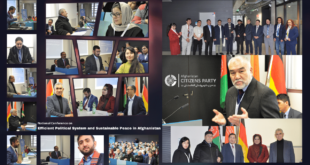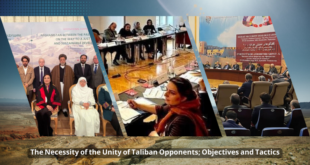Two-year report card of Talabani’s reign of holy ignorance over Afghanistan
By Mohammad Shafaq Khawati
The Taliban’s return in 2021 was a storm that felled the young tree of democratic aspirations in Afghanistan. This terrorist group, whose only skills are slaughter, destruction, and devastation, not only hinders Afghanistan’s progress toward brighter horizons but is dragging the country back centuries in time, transforming it into a hell for its citizens.
Millions have fled their homeland for various countries while hundreds lost their lives on smuggling routes. The majority, unable to leave the country, remain trapped in a prison named Afghanistan, where even breathing is a challenge. The Taliban aim to gradually eradicate all who do not share their beliefs or lineage, plundering their lands, properties, and assets, and labeling them as apostates to justify their extermination.
Below, I touch upon only a few aspects of what has befallen the people of Afghanistan under the rule of the Taliban over the past two years and what continues to occur.
1. Religious autocracy and ethnic monopoly in the absence of a constitution
Despite the Taliban’s efforts to enforce their harsh narrative of Islam, they are inherently an ethnically-centered group that uses Islam to legitimize their ethnic power. More than 90 percent of the positions at the ministerial and provincial levels of the Taliban emirate are held by members of the Pashtun ethnic group. The Taliban supreme leader, the chief justice, and other high-ranking officials of the Taliban regime are all Pashtuns. Moreover, 31 out of the 34 members of the Taliban’s cabinet are Pashtuns. Only three members of the cabinet belong to the Tajik and Uzbek ethnic groups. By including these three non-Pashtun members, the Taliban aim to demonstrate to the people and the international community that representatives from other ethnicities are also part of their regime. The ethnic make-up of the Taliban’s governors mirrors that of the cabinet – there isn’t a single Hazara minister or governor, nor is there a single Shia minister or governor throughout this emirate, despite the size of those groups.
The Taliban’s autocracy and monopoly are not founded on any established law; they view the constitution as a symbol of disbelief. An entire nation is held hostage to the whims of one man, Mullah Haibatullah. His edicts are purportedly based on divine law. To oppose him is seen as apostasy, which is punishable by death. To legitimize Haibatullah’s mandates, a book was authored by Abdul Hakim Sharee, the Taliban’s chief justice,titled “Islamic Emirate and its System.” Rather than resting on a religious foundation, this book offers an interpretation of sharia that is heavily influenced by stringent tribalistic rules. Within its pages, women are dehumanized, deprived of the rights to engage in societal activities, pursue education, or work. This perspective is wrongly attributed to Islam and the Hanafi school of thought. In reality, the founder of the Hanafi school believed that no one should declare themselves as a leader without the consent of the people and the legitimacy of their rule should fundamentally be based on prior approval and election by the populace.
2. The status of women
To dehumanize women, the Taliban have issued 50 decrees in the past two years imposing restrictions on them, according to a report published in June 2023 by Richard Bennett, the UN special rapporteur on human rights in Afghanistan. These decrees deprive women of the right to education and the right to work, and also impose severe restrictions on their presence in society, markets, cities, and even parks. Since that report, numerous other orders relating to new restrictions on women have been issued by the Taliban. These include banning the education of girls more than 10 ten years old in Ghazni province and the closing of women’s beauty salons throughout Afghanistan. The only place where the Taliban allow women to be present is in religious schools, which are designed to nurture an even more ruthless and bloodthirsty generation of terrorists for the future of Afghanistan and the world.
Some women have been arrested or, in some cases, stoned to death, after being seen in public with a man who is not her husband or close male relative. Meanwhile, Taliban members forcibly marry young girls, and many Taliban commanders have coerced two, three, or even four women into marriage. Several of these women have committed suicide, and others who have managed to escape have reported the horrors they endured. Some of the senior Taliban who have forced young girls to be their wives are Mullah Zain-ul-Abedin, the 60-year-old Taliban governor in Laghman; Saeed Khusti, the Taliban spokesperson; and Mullah Mohammad Yasin in Balkh province. Not only have they avoided scrutiny from the Taliban’s judicial system, but Saeed Khusti urged Taliban supporters in other countries to cut down the throat of Taliban opponents with knives.
Based on documented reports, mid-level Taliban officials jdetain large numbers of girls during the night, take them to their ministries and offices, where they sexually abuse them, and then threaten that, if they disclose the abuse, both they and their families will be annihilated.
3. The status of members of the previous government, reporters, and civil and human rights activists
In the past two years, several hundred individuals, including military personnel, scholars, judiciary members, politicians, journalists, and human rights defenders, have been arrested, beaten, or assassinated in Kabul and other provinces. Many abductions occur at night. Some are killed, their bodies dumped. Others just disappear, leaving their families unaware of their fate. Freedom of expression has been completely eradicated, and the slightest criticism of the Taliban is met with the brutal reprisals.
4. The plight of non-Pashtun ethnic groups
Although many Pashtuns (such as the Achakzai tribe in Kandahar, etc.) have not been immune from the crimes committed by the Taliban, the dominance of the Taliban has been a double tragedy for non-Pashtun ethnic groups, especially the Hazaras and Shias. While all suffer from the extremism and inherent violence of the Taliban, the Hazaras, due to their ethnicity and religion, face manifold oppression, even physical elimination. Under the gaze of the international community, the Taliban readily implement a program to eradicate non-Pashtuns, especially the Hazara community. Some examples are:
1. De-Persianification of Afghanistan:
In the past two years, the Taliban have tried to replace Persian (or Dari-Farsi, the inter-ethnic or lingua franca of Afghanistan) with Pashto, even though Persian has been the symbol of identity and a common language of this land for thousands of years, as well as the language of renowned thinkers, poets, and scholars on a global scale. Signs of government offices and universities are now exclusively in Pashto, and the Taliban officials have announced that “We do not need Persian literature.”
2. Forced eviction and displacement:
After the Taliban’s takeover of Afghanistan, forced displacement of Hazaras has occurred in various provinces. In Daykundi and Uruzgan provinces alone, 17 instances of forced migrations involving more than 4,000 families have taken place in the last two years. Approximately 12,000 jeribs (a local land measurement equal to 2,400 hectares) of agricultural lands as well as their houses, have been seized by the Taliban and given to Pashtuns and others supporters. Similar land grabs occurred in Ghazni, Bamiyan, Ghor, Balkh, Herat, Kandahar, and Maidan Wardak. House burnings and scorched earth policies have also been observed in several provinces, including Ghazni, Maidan Wardak, and other Hazara-populated provinces.
3. Extortion
Although tithing is prevalent throughout Afghanistan, the Taliban use pretexts to forcibly collect tithes from the poor Tajik, Hazara, and Uzbek populations. This includes seizing the possessions of people who cannot even afford enough food for their families. The Taliban also impose tithes on Shia religious schools.
4. Regime-led homelessness
Destroying people’s houses, especially the homes of Shia Hazaras, the Jogi in Kabul, the Tajiks and Sunni Hazaras in Baghlan and other provinces, is another tactic adopted by the Taliban.
5. Kuchi unleashed
Nomads backed by the Taliban are encroaching upon, or seizing, farms of the Hazaras, using the lands as grazing grounds for their livestock. Complaints from farmers often go unheard, and in several cases, the complainants have been beaten and arrested by the Taliban. The number of such tragedies is vast, too numerous to list in this summary.
6. Religious restrictions:
Strict religious constraints have been imposed on Shia Hazaras and other Shia minorities.. Shia personal status laws have been abolished, Shia judges have been expelled from courts, and their religious ceremonies have been severely restricted or prohibited. The plight of Hindus and Sikhs in Afghanistan under the Taliban regime is equally distressing, and many have been forced to leave Afghanistan.
In conclusion, the return of the Taliban does not just mean halting Afghanistan’s journey towards brighter horizons or merely obstructing its path to development. It also signifies Afghanistan’s regression by at least a century. Political tyranny and monopoly by a single ethnic ideological group leads to the cultural and economic collapse of the society and shatters the spirit and psyche of its people.
Not only are the gates of schools and universities closed for girls, but even boys don’t have an adequate educational environment anymore. Most private universities are semi-shut, and about three-quarters of university professors and students from public and private institutions have been fired or fled the country, part of an unprecedented exodus of elites and educated individuals.
Today’s Afghanistan has become a prison for its residents, and the security provided by the Taliban resembles that of a jail or a graveyard. The current fragile situation and enforced security are like embers beneath ashes, bound to erupt one day. Since the Taliban’s takeover of Afghanistan, not only has there been no positive change in their approach, but their restrictions and oppressions have been intensifying daily. If no change in the political system and an all-encompassing popular government emerges, it seems that civil war is inevitable, sooner or later.
Mohammad Shafaq Khawati has a Ph.D. in political science.
 حزب شهروندان افغانستان وبسایت رسمی حزب شهروندان افغانستان
حزب شهروندان افغانستان وبسایت رسمی حزب شهروندان افغانستان


